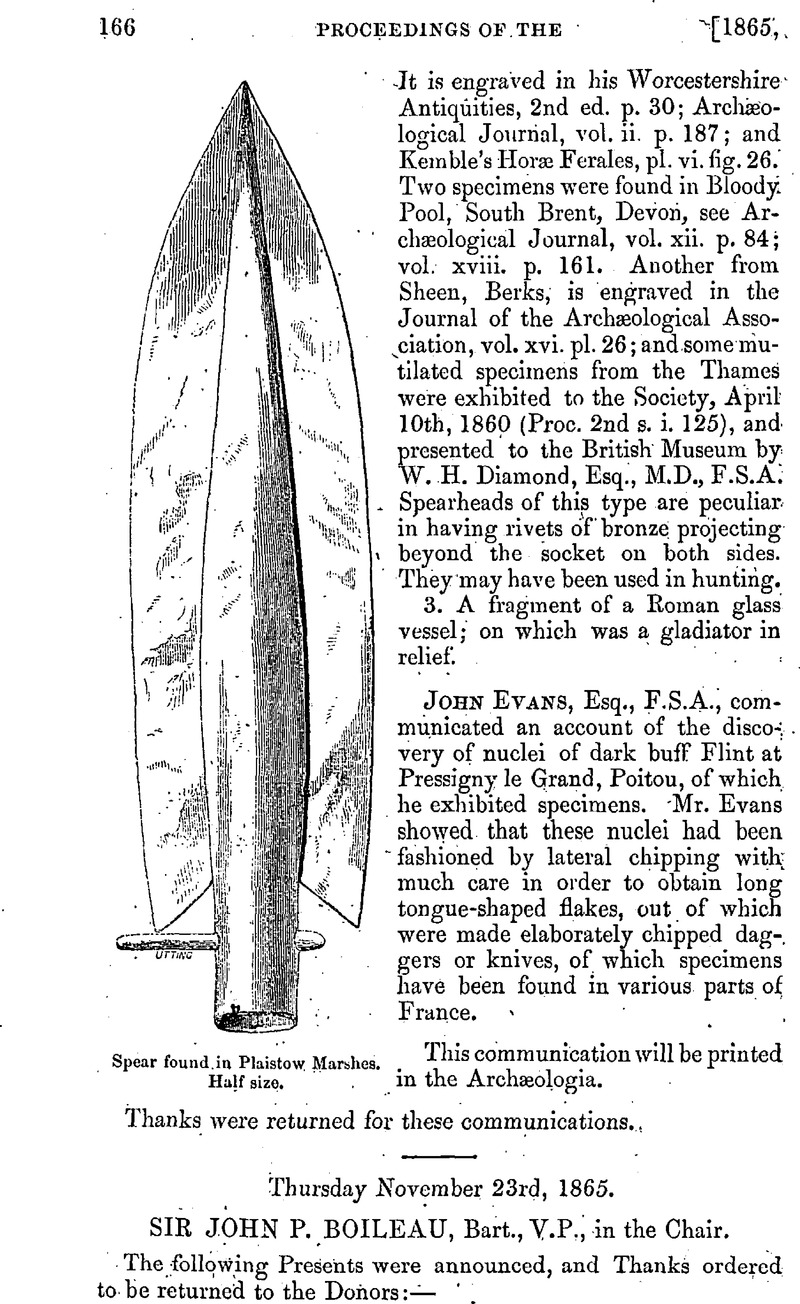No CrossRef data available.
Article contents
Thursday November 23rd, 1865
Published online by Cambridge University Press: 10 May 2010
Abstract

- Type
- Proceedings
- Information
- Copyright
- Copyright © The Society of Antiquaries of London 1867
References
page 168 note * Vol. xxxviii. p. 410. Salisbury vol. of Arch. Institute, 1849, p. 98. By the peasantry of the neighbourhood this barrow is known as “Old Adam,” (meaning Adam's grave,) and one of the stones at its base as “Little Eve.” It is a conspicuous object in plate 2 of Hoare's Ancient Wilts, vol. ii. p. 8. The hill, corruptly called “Walker Hill” on the ordnance map, is by the shepherds more properly called Walcway Hill. It is crossed by the ancient British ridge-way (continuation of the Icknield),—the Weala-wege or Welsh-way of an Anglo-Saxon charter in the Codex Winton (Alton Priors). See Jones's Domesday for Wiltshire, 1865, p. xxvii.
page 169 note * For this barrow see Proc. Soc. Antiq. 2nd 8. vol. ii. p. 275. Crania Britannica, plate xxvii. 59, p. (3). Small, but not very good, woodcuts of the arrow-heads are given by Mr. Lysons in his recent work, entitled “Our British Ancestors,” 1865, p. 150.
page 169 note † Archæologia, vol. xv., pp. 340, 345. Ancient Wilts, vol. i. passim.
page 169 note ‡ Ten Years' Diggings, 1861, pp. 145, 146. Catalogue, p. 37, 208 C. See the “Reliquary,” vol. v. p. 27, for a ground-plan of Long Lowe, and a further description.
page 169 note § Ibid. pp. 95, 96.
page 170 note * Ten Years' Diggings, 1861, pp. 230, 276.
page 170 note † See the barbed arrow-heads found in round barrows, described by Sir R. C. Hoare, sometimes with the entire skeleton, “Ancient Wilts.” i. 211, pl. xxx., 239, pl. xxxiv. (in the latter case with a fine bronze dagger blade); and sometimes with burnt bones, “Ancient Wilts.” i. 183, pl. xxii. In two or three other instances, there is nothing to shew whether the arrow-heads were of the barbed, or simple leaf-shape. Ibid. i. 104, 209, 242.
page 171 note * Ancient Wilts, i. 104.
page 171 note † Such are the four beautiful leaf-shaped javelin heads found in the oval barrow (No. 49) (on Winterbourn Stoke Down, and described in Proc. Soc. Ant. 2nd s. vol. ii. p. 427.) For all purposes of argument oval barrows (as distinguished from long barrows) and round barrows may be regarded as identical. The two are clearly coeval, and the work of the same people. An oval barrow in my view is a congeries of two or more round barrows.
As this sheet was going through the press, I have received “The Celtic Tumuli of Dorset,” by Charles Warne, F.S.A. In this volume (errata p. 15; comp. p. 16, 27) is a woodcut of four leaf-shaped flat arrow or javelin heads from an oblong barrow on Pistle Down, Dorset, opened by Dr. Wake Smart in 1828. The coincidence with my Winterbourn Stoke discovery is not a little curious. Dr. Smart informs me that the tumulus was “of no great height, and had nothing in common with the true Long Barrow, and only deviated from the ordinary type of Roman Barrow by presenting an oval or somwhat oblong shape.” It was doubtless one of those I have distinguished as Oval Barrows.
page 171 note ‡ Such a discovery as that by Mr. J. R. Mortimer, of leaf-shaped arrow and javelin heads in a circular barrow on Bishop Wilton Wold, in the East Riding of Yorkshire, and which has been described by Dr. J. Barnard Davis in the “Reliquary,” vol. v. p. 185, and since brought by him under the notice of this Society (Meeting of May 17th, 1866), is by no means inconsistent with the conclusions alluded to in this Communication.
page 172 note * Since this was written I have discovered that the fictile remains in the long barrow are of a quite distinct and peculiar type. Pottery of any kind, however, is of very rare occurrence in them as associated with the primary interments.




